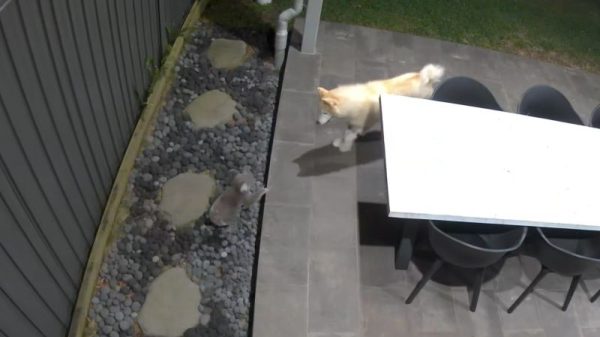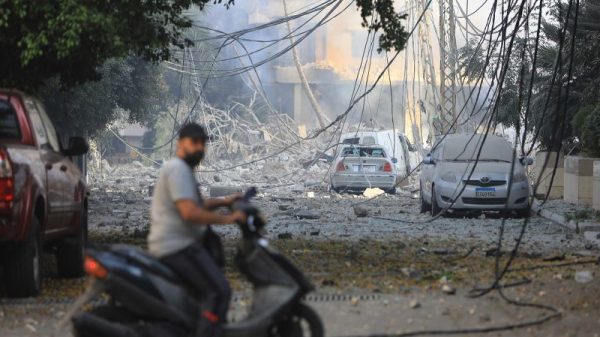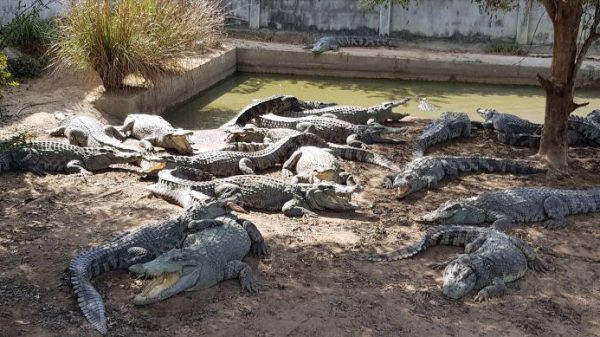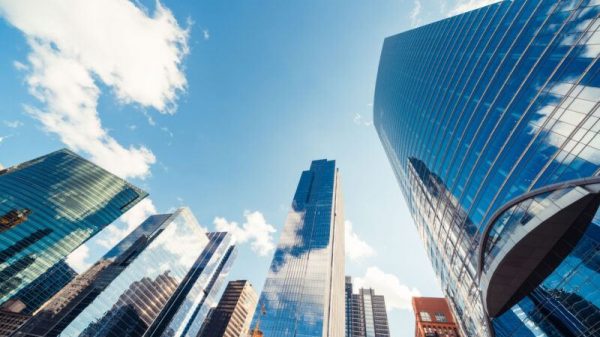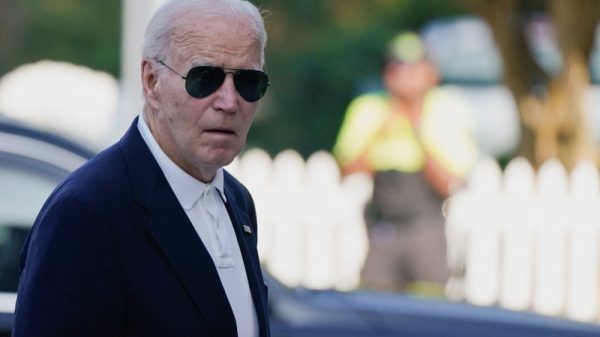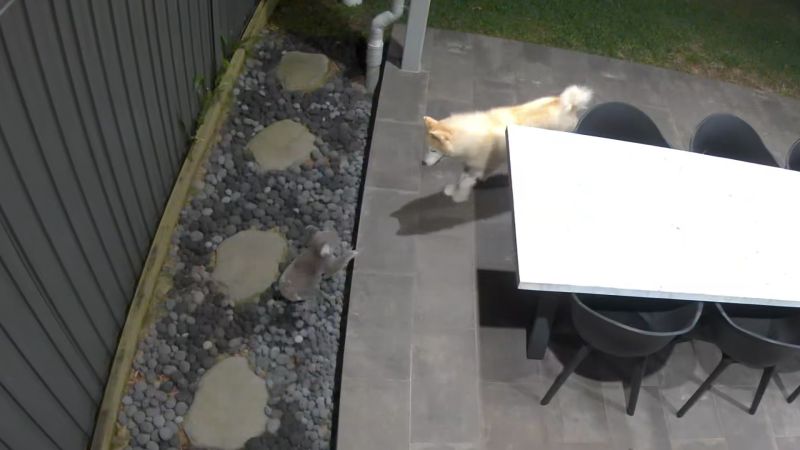One was a koala. The other was a husky. Both were arguably out of place on a warm August night in subtropical Brisbane, the capital of Queensland in Australia’s northeast.
Home security video captured the moment they locked eyes in a suburban backyard surrounded by a high metal fence.
With deep rumbling growls, the koala advanced towards the retreating dog, for a moment appearing as the aggressor in an encounter that typically ends with a dead marsupial.
But not this time.
From the street, neighbor Sophia Windsor heard growling and barking and raced to the backyard to see the dog shaking the koala by the belly, then the koala grabbing the dog around the neck.
“I wasn’t even really thinking, and I just pried the koala off this poor dog, who was now yelping, and then kind of wrapped up the koala then ran back out the front to the driveway where my daughter was waiting,” said Windsor.
“And she’s like, ‘You’re carrying a wild koala.’”
Koalas are very hard to see at night.
Their gray fur blurs with the bitumen on dimly lit roads, and they move deceptively quickly for a marsupial often seen languidly munching on leaves high in trees.
But for an endangered species whose population numbers are said to be unreliable due to their elusive nature, koala sightings are becoming all too common during breeding season in some areas in and around Brisbane. And not just in trees.
Day and night, they’re spotted close to busy roads, on fences, up power poles, in backyards, near swimming pools, in schools – places they aren’t safe.
Some are on the ground, having been hit by cars or attacked by dogs. Others are clearly sick, with dirty eyes and behinds – telltale signs of chlamydia, an infectious disease that spreads quickly in stressed populations.
And koalas in Queensland are stressed.
Experts believe the population declines that saw them listed as endangered in 2022 have not reversed.
And some fear that by the time Brisbane hosts the Olympic Games in 2032, the only koalas left in the “world’s koala capital” will be in forests far outside the city.
Rescued twice in 24 hours
After Windsor grabbed the koala off the dog, she stood with the injured marsupial tucked under one arm and desperately fumbled with her phone to call for help.
“I was running on adrenaline. I actually paused as I was doing it, and went, ‘Oh my God. They’re really soft and cuddly, like a real teddy bear.’ And that was whilst he was biting my hand.”
“They have a really, really strong bite.”
She called a friend, who phoned John Knights, a veteran koala rescuer from the United Kingdom who’s caught more wild koalas than most Australians see in their lifetime.
Knights, 74, answers calls around the clock, jumping into a utility vehicle loaded with custom-made koala-catching paraphernalia: traps, cages, warning signs, poles, nets and countless tools.
He’s responded to more than 100 emergencies in two months – twice as many as last year – which he puts down to two strong rainy seasons that have led to a koala boom in Brisbane’s southern suburbs.
Knights says he’s not sure how much longer he can keep doing this – his pension doesn’t cover his rent and no one’s paying for this service.
However, before he had time to answer Windsor’s cries for help, she walked to a nearby tree and released the koala.
Big mistake.
Koalas have small brains that don’t cope well with being shaken.
Knights was concerned that after scurrying 20 meters (66 feet) up a tree, high on adrenaline, the koala might slowly deteriorate and die on the branch or be attacked again after climbing down.
So, an expert climber was called to catch it, but a rescue would have to wait until the morning.
Murray Chambers stood on the street, near passing traffic, observing the challenges that lay ahead of him.
“Everything,” he nervously laughed. “You’ve got power lines, which is a no-no for starters. Trees are interlocking, so he can jump from one tree to another.”
What about the height? “Been higher than that,” he said.
Chambers, from Koala Rescue Queensland, has been climbing trees to catch koalas for 20 years.
Now he receives fewer calls each week – sometimes five, sometimes none.
“We’re losing them, so there’s less cases,” he said.
Before long, Chambers inched his way up the tree and after several hushed minutes from onlookers, he caught the koala in a net as it tried to jump between branches.
Every koala transported to the RSPCA Wildlife Hospital for medical help gets a name and a numbered tag. Windsor’s finger-biting wild koala was assigned number 1561 and called “Trent,” after a nearby street.
Knights does not recommend people attempt to catch a koala.
As Windsor found out, they have a fearsome bite and sharp claws that can easily rip skin.
National rescue effort underway
Koalas mostly live down Australia’s eastern coast, and they’re endangered in New South Wales and the Australian Capital Territory, as well as Queensland.
In 2022, a 10-year national recovery plan was launched to stop the decline in numbers and improve the size, quality and connectivity of koala habitat in the listed areas.
Millions of dollars have been spent on restoring koala habitat, but two years on, listed populations are still declining, and the long-term survival prospects for wild koalas remain “poor,” according to the annual report released in May.
The Queensland government had already introduced what it calls the “strongest koala habitat protections ever seen” in the state – with some payoff, according to a spokesperson for the Department of Environment, Science and Innovation (DESI).
Koala populations have stabilized in forests outside cities, but not in urban and semi-rural areas due to “human activity and domestic dogs,” the spokesperson said in a statement.
In the last six years, the RSPCA’s two wildlife hospitals in South East Queensland have treated more than 5,000 diseased and injured koalas.
With a euthanasia rate of 66%, most don’t make it.
Veterinarian Tim Portas says the animals are put to sleep if they’re unlikely to recover enough to survive on their own in the wild.
“I think within 20 or 30 years, if things don’t change, they’ll be gone in southeast Queensland,” Portas said.
“I often think, ‘Am I sitting here, seeing the last of Queensland koalas filtering through, as I work with them?’”
One of three subspecies, Queensland koalas are smaller and grayer than their southern cousins, and are the kind often seen in photos with celebrities and foreign dignitaries.
Habitat loss
As part of the national recovery plan, the federal government committed 76 million Australian dollars ($52 million) to the Saving Koalas Fund over four years to “support the recovery and long-term conservation of the koala and its habitats.”
The Queensland government added another 31 million Australian dollars ($21 million) for koala conservation in its latest budget, and says that, of more than 714,000 hectares of mapped koala habitat in the southeast, about half is exempt from any type of development.
Furthermore, the state has set “an ambitious target to commence rehabilitation to restore 10,000 hectares of koala habitat in South East Queensland by 2025,” the spokesperson said in the statement.
But conservationists say it’s nowhere near ambitious enough, given the scale of deforestation that’s occurring elsewhere.
“It’s an incredibly low ambition and woefully inadequate,” said Natalie Frost, from the Queensland Conservation Council.
In Queensland, over 320,000 hectares of “woody vegetation” was cleared during the 2021-22 financial year, according to government figures.
Of that, 88% was cleared for pasture, mostly for cattle grazing, while 1% was for development.
Greenpeace said most of the clearing required no permission.
“What we know from Queensland deforestation data is each year, 70-80% of all deforestation requires no state level approval or oversight. On top of this, the majority of deforestation is never sent to the federal government for approval,” said Gemma Plesman, senior campaigner at Greenpeace Australia Pacific.
“Aussies would be horrified to know that we are bulldozing koala habitat at the rate that we are,” she said.
Most of the clearing was carried out in the Brigalow Belt, north of Brisbane, and in the Mulga Lands, to the southwest – areas identified as having the state’s highest koala population estimates, according to the 2022 conservation advice.
Climate change is also making the state’s inland areas drier and hotter, depleting nutrients in the leaves that koalas rely on to survive.
“A lot of the population modeling suggests that koalas will be shifting eastward and southward … and so along the east coast where we’re getting increased pressures from urban development,” said Frost.
Koala habitat squeezed in cities
With a human population of 2.5 million, Brisbane is one of Australia’s fastest-growing capital cities.
On the city’s outskirts, land is being cleared for new housing developments and amenities to service expanding suburbs.
Jo Murray has been living in Lawnton, a 40-minute drive north of Brisbane’s city center, in the Moreton Bay region, for 40 years.
When she first moved in, she was surrounded by dozens of koalas living in eucalyptus trees, their main source of shelter and food.
“If you went out for a walk early morning or evening, you would be almost sure to see a koala,” Murray said.
Over time, blocks have been cleared for housing and, earlier this month, woodcutters arrived next door and cut down towering Eucalyptus tereticornis trees, known as forest red gums, up to 28 meters (over 90 feet) tall, to make way for another prospective residential development.
Landowners are able to clear 500 square meters – about the size of an NBA basketball court – without formal permission. Separate exemptions exist for firebreaks and road access, among other reasons.
Garth Nolah, from Nolah Property Developments, who advised residents of the tree-clearing, said a development application would be submitted soon and declined to comment further.
She said she has saved local koalas Beau and Louis multiple times over the years and can’t face having to do it again.
“Once those trees all go, Beau and Louis are not going to be with us,” she said. “I don’t want to be the one who picks either of them up.”
Months earlier, when Murray learned that the neighboring lot had been advertised for sale, she started a petition and wrote emails to the state government pleading for something to be done to protect the trees.
Murray said the lack of response to her emails – and the subsequent loss of the trees – had made her question Queensland’s commitment to protecting urban koalas.
“If they’ve decided that they don’t want koalas in urban areas, and they’re not prepared to protect them, then they should just tell us,” she said.
Declining numbers
Most of the ambition for vast tracts of new koala habitat in Queensland lies outside Brisbane’s established inner-city suburbs.
Creating corridors within older residential areas requires much more inventive measures, according to Dr Bill Ellis, an expert in koala ecology from the University of Queensland.
Fences have been built with log climbers that offer escape routes from busy roads, and two years ago Brisbane City Council built a bridge over a thoroughfare near a wildlife reserve.
The bridge has helped many possums cross the road, and at least one koala, based on footage from a wildlife camera from the last eight months.
“Brisbane is the koala capital of the world and we are committed to making sure it stays that way,” Brisbane Lord Mayor Adrian Schrinner said in a statement.
Ellis said the bridge is a promising start, but that “some relatively dramatic interventions” are required to ensure koalas survive in suburban Brisbane.
“It may be that we need a whole lot of those bridges, and we’ll get a whole lot of movement, I’m not sure,” he said.
“But the capacity to move koalas from one side of a road to the other is not beyond us. It’s just a question of willpower and money.”
He hopes that koalas will survive in suburban Brisbane long enough for international visitors coming to the Olympics to see them in 2032.
“Either we change what we’re doing in southeast Queensland, or we’re going to be sending people well out of the city and well out of our suburbs in order for them to see a koala,” he said.
“And I think that’d be pretty sad.”
Trent’s second chance
In some ways Trent was lucky – the husky who shook him was a pleasant pet called Nine Nine who, at 12 years old, was not a natural predator for a lost koala.
According to the vet’s notes, Trent suffered superficial wounds to his chin, some chest trauma and mild abdominal bleeding.
“Stress attributed to hospital environment, ready to go back out there,” the notes added.
So, five days after the dog attack, Knights chose a tree several meters off the track on Mount Gravatt Outlook Reserve in Brisbane’s southern suburbs where Trent could feel more at home.
He was accompanied by some members of an eclectic and growing team of volunteers, who come together when called to hold a torch, carry a net, or “tree-sit” – sometimes through the night – to stop koalas from wandering into traffic.
The group includes a midwife, tattoo artist, public servant, automotive spray painter, student, speech pathologist, software engineer and at least one retiree – all local residents who are desperately concerned for the welfare of an Australian national icon.
Releasing koalas is one of the rewards of what can be a heartbreaking task.
So far this year, they’ve counted at least 52 dead koalas within a six-kilometer radius of nearby Whites Hill Reserve. Another 26 are assumed to have been euthanized by wildlife vets due to injury.
Having received a tetanus shot for her koala bite – a rare injury even in Australia – Windsor watched as Knights opened the cage and Trent bounded up a tree.
“That was amazing. That was worth every bite one thousand times!” Windsor said.
Knights reckons he’s saved thousands of koalas during his 10 years of service.
He says they need more trees to be able to move safely through urban areas and rejects any suggestion that koalas have become urbanized or accustomed to navigating suburban streets.
“They’re frightened. They’re lost,” he said.
“If they were urbanized, they wouldn’t be running into the traffic, they wouldn’t be turning up in backyards, they wouldn’t be falling into swimming pools. They’re not urbanized at all,” he said.
“They’re looking for somewhere to live.”






